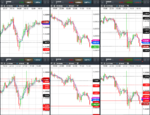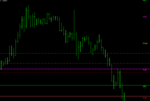Results for GBPUSD, EURGBP & EURUSD Friday 5th Jan - NON-FARM PAYROLL DAY
Thursday night I attached the predicted support and resistance levels of GBPUSD from the Volatility Response Model (VRM). EURGBP and EURUSD were also available at
https://www.complexhamiltoniansystems.com/fxcharts/
I attach the results for the triplet GBPUSD, EURGBP and EURUSD.
Weekly levels in the top 30 minute charts, daily levels in the bottom 30 minute charts. Times are GMT-4 . EMA channel (4,7) included.
On the high side EURUSD hit weekly VRM level 1.2083. I have the high for the day as 1.20838. On the low side EURUSD hit the VRM level 1.2022. I have the daily low as 1.20204.
The EURUSD levels 1.2083 and 1.2022 were calculated last weekend before the New York open.
EURGBP followed EURUSD down to the daily VRM level 0.8863.
GBPUSD was trapped in the daily sentiment levels between 1.3570 and 1.3523.
As the EURUSD hit the weekly VRM level 1.2083 and fell rapidly from there I believe that the GBPUSD and EURGBP markets were following the EURUSD market on non farm payroll day.
There were some large gaps between VRM levels to trade between.
Predictions for Sunday and Monday to follow.
Thursday night I attached the predicted support and resistance levels of GBPUSD from the Volatility Response Model (VRM). EURGBP and EURUSD were also available at
https://www.complexhamiltoniansystems.com/fxcharts/
I attach the results for the triplet GBPUSD, EURGBP and EURUSD.
Weekly levels in the top 30 minute charts, daily levels in the bottom 30 minute charts. Times are GMT-4 . EMA channel (4,7) included.
On the high side EURUSD hit weekly VRM level 1.2083. I have the high for the day as 1.20838. On the low side EURUSD hit the VRM level 1.2022. I have the daily low as 1.20204.
The EURUSD levels 1.2083 and 1.2022 were calculated last weekend before the New York open.
EURGBP followed EURUSD down to the daily VRM level 0.8863.
GBPUSD was trapped in the daily sentiment levels between 1.3570 and 1.3523.
As the EURUSD hit the weekly VRM level 1.2083 and fell rapidly from there I believe that the GBPUSD and EURGBP markets were following the EURUSD market on non farm payroll day.
There were some large gaps between VRM levels to trade between.
Predictions for Sunday and Monday to follow.








